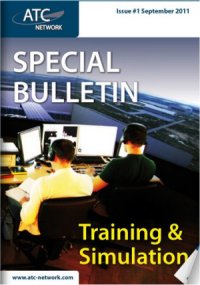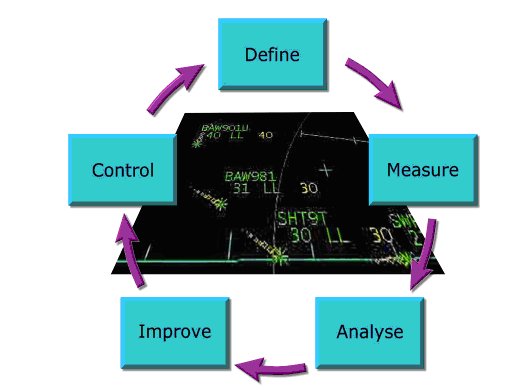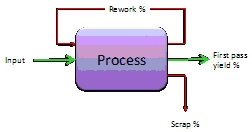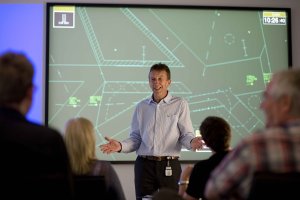
This article appeared in the 'Training and Simulation' Special Bulletin published in September. You can view the full publication in our 'Publications' archive or go to http://www.atc-network.com/training
Authors: George Tosh NORTHSTAR/ Garry Jackson NATS
In this article we find out how the UKs ANSP NATS (En Route) have spent the last four years transforming ab-initio ATCO training. Their starting point was the application of Lean Six Sigma techniques in a unique way to tackle the challenge of training new ATCOs for its business. The rigour and insights gained from applying Lean techniques created the right platform for a robust improvement programme. These put NATS in exactly the right place for a move to a stunning new facility and deliver significant improvement in it's course results.
Authors: George Tosh NORTHSTAR/ Garry Jackson NATS
In this article we find out how the UKs ANSP NATS (En Route) have spent the last four years transforming ab-initio ATCO training. Their starting point was the application of Lean Six Sigma techniques in a unique way to tackle the challenge of training new ATCOs for its business. The rigour and insights gained from applying Lean techniques created the right platform for a robust improvement programme. These put NATS in exactly the right place for a move to a stunning new facility and deliver significant improvement in it's course results.
 Back in 2008, NATS, in common with many ANSPs, faced a forecast manpower shortage of en route controllers. The training process at that time was long, expensive and subject to quite a bit of variation as to whether trainees would make it or not. Not unnaturally the business sought to solve the problem of not enough successful trainees by recruiting more thus loading up the process and further compounding the problem.
Back in 2008, NATS, in common with many ANSPs, faced a forecast manpower shortage of en route controllers. The training process at that time was long, expensive and subject to quite a bit of variation as to whether trainees would make it or not. Not unnaturally the business sought to solve the problem of not enough successful trainees by recruiting more thus loading up the process and further compounding the problem.
 Garry Jackson, (Director, Training and Simulation) The uncertainty of how many qualified trainees would be delivered to the operational units was a major cause for concern. Growing demand combined with an aging ATCO population meant that we had to find a way to meet our numbers.
Garry Jackson, (Director, Training and Simulation) The uncertainty of how many qualified trainees would be delivered to the operational units was a major cause for concern. Growing demand combined with an aging ATCO population meant that we had to find a way to meet our numbers. Garry was appointed to take over the running of the Training College in 2008 and set about making changes. NATS Business improvement group offered support to run a diagnostic on the training process and provided help in the form of external consultancy firm Northstar, who supported NATS with the deployment of Lean Six Sigma. It was a great opportunity for us to showcase the power of Lean Six Sigma in a business-critical area.commented George Tosh, Director at Northstar. We followed the DMAIC process, Define the problem, collect data to establish Measures, Analyse the data to find root causes, implement Improvements following good project management practices, and create Controls to maintain and continue the improvement process.

The figure below provides a simple view of any given process step:

All very well in a factory, but how does it apply to the people-intensive process of training? George explains,
This manufacturing analogy worked well in the training college, particularly in relation to how we identified and quantified waste, and tying a financial value to that waste meant that we had all the attention and leverage we needed to implement changes. Getting those involved to think in the factory model was initially a challenge, George again, This took a bit of time to bed in, professional trainers found it difficult to accept trainees as product; these are people were talking about here being a typical response. Introducing a different slant to the thinking was crucial to getting everyone to buy in to the changes we were making.
This manufacturing analogy worked well in the training college, particularly in relation to how we identified and quantified waste, and tying a financial value to that waste meant that we had all the attention and leverage we needed to implement changes. Getting those involved to think in the factory model was initially a challenge, George again, This took a bit of time to bed in, professional trainers found it difficult to accept trainees as product; these are people were talking about here being a typical response. Introducing a different slant to the thinking was crucial to getting everyone to buy in to the changes we were making.
 As mentioned earlier the focus on treating causes, as opposed to symptoms, meant that improvements were tangible. Using the data collected we were able to clearly demonstrate the impact of rework (re-coursing failed students) on the overall training capacity, quantifying the cost-of-poor-quality and the bottleneck. Armed with these data we were able to build an overwhelming case for where to make improvements.
As mentioned earlier the focus on treating causes, as opposed to symptoms, meant that improvements were tangible. Using the data collected we were able to clearly demonstrate the impact of rework (re-coursing failed students) on the overall training capacity, quantifying the cost-of-poor-quality and the bottleneck. Armed with these data we were able to build an overwhelming case for where to make improvements. The data collection and analysis exercise included input from all areas involved and culminated in a one-day management event to brief the findings. This was a major turning point in the project., said Garry, Everyone involved in training, from the CEO downwards, had a data-rational view of the end-to-end process and complete visibility of the issues and causes. Everyone bought in to the need to drive positive change.
 The Analyse phase identified a number of key changes which needed to be implemented, the most critical being courseware changes required to enhance radar skills during Basic training.
The Analyse phase identified a number of key changes which needed to be implemented, the most critical being courseware changes required to enhance radar skills during Basic training. The next challenge was creating the space in the training schedule to make the changes. As with any other business keeping the production line going and freeing up resources to make necessary changes is a major trade-off. Garry Jackson We knew we could not meet our output and implement the changes we needed with the instructor resources available. Given the weight of the evidence and the improvement in pass rates we could achieve if we implemented the changes the decision was simple we had to focus on improvement.
 A dedicated, collocated project team was created from the instructor community, and a plan of work created to redevelop Basic courseware and simulator exercises, fully adopting the guidelines and taxonomy provided under ESARR5 T14 (later replaced with the Specification for the ATCO Common Core Content Initial Training).
A dedicated, collocated project team was created from the instructor community, and a plan of work created to redevelop Basic courseware and simulator exercises, fully adopting the guidelines and taxonomy provided under ESARR5 T14 (later replaced with the Specification for the ATCO Common Core Content Initial Training). The revised course was created, tested and rolled out for en-route training in a 4 month period. The results were dramatic, first pass yield more than doubled to over 70%. In simple terms this created a third more training capacity, exactly what was required to meet demand.
The team found other issues during the Measure and Analyse phase, and prioritised these to form an improvement plan for the college. The college established its own internal improvement capability by training 25 of its staff in Lean and Six Sigma Techniques.
A programme of Continuous Improvement was established with key projects undertaken including:
The new centre is a 4000 square metre state-of-the art facility that will train air traffic controllers from across the globe. There are 6 simulator rooms with a total of 45 trainee positions which recreate the live air traffic control environment and ensure the best possible learning experience for controllers of the future. The facility also has 6 purpose-built classrooms and access to other training rooms and meeting rooms at the centre. Each room has SMART board technology and flexible furniture so the instructor community can take the advanced teaching techniques given to them through the ATLAS Programme to new levels.
One of the most valuable lessons NATS has learned over the years is to create an environment that enables its people to be actively involved in the improvement process. With this in mind, NATS took the bold step to offer its staff the opportunity to design their new training facility. NATS applied change management best practice and established a User Group made up of staff from the Instructor, Support and Administration departments. The User Group was tasked with defining the training centre requirements and then working closely with a core project team in the design, development and implementation of all aspects of the project including workstation design, building layout and classroom design. A governance process involving all key stakeholders was established to ensure the facility was fit for purpose.
- Improvement of the Recruitment & Selection Process for trainees.
- Advanced Teaching Learning and Assessment Skills training for ATC instructors and support staff (called the ATLAS Programme).
- Introduction of Trainee Progress Tracking to support decision making and the identification of supplementary training requirements.
- The introduction of Modularised Training course Design enabling trainee output to be tailored to customer requirements.
The new centre is a 4000 square metre state-of-the art facility that will train air traffic controllers from across the globe. There are 6 simulator rooms with a total of 45 trainee positions which recreate the live air traffic control environment and ensure the best possible learning experience for controllers of the future. The facility also has 6 purpose-built classrooms and access to other training rooms and meeting rooms at the centre. Each room has SMART board technology and flexible furniture so the instructor community can take the advanced teaching techniques given to them through the ATLAS Programme to new levels.
One of the most valuable lessons NATS has learned over the years is to create an environment that enables its people to be actively involved in the improvement process. With this in mind, NATS took the bold step to offer its staff the opportunity to design their new training facility. NATS applied change management best practice and established a User Group made up of staff from the Instructor, Support and Administration departments. The User Group was tasked with defining the training centre requirements and then working closely with a core project team in the design, development and implementation of all aspects of the project including workstation design, building layout and classroom design. A governance process involving all key stakeholders was established to ensure the facility was fit for purpose.
 Reflecting on the move of the college, which was successfully delivered in August 2011, Garry Jackson said This is the culmination of a whole series of changes and improvements we have made within Training and Simulation. We now have a completely new working environment one developed by our User Group and the wider college community in association with the project team. We have created something that ensures we can provide world class training to all our internal and external customers for many years to come.
Reflecting on the move of the college, which was successfully delivered in August 2011, Garry Jackson said This is the culmination of a whole series of changes and improvements we have made within Training and Simulation. We now have a completely new working environment one developed by our User Group and the wider college community in association with the project team. We have created something that ensures we can provide world class training to all our internal and external customers for many years to come. The new location is just 3 miles from the Swanwick Centre. This close proximity has many benefits because it is now so easy for all members of the training community to be in closer contact, and break down the perceived barriers of the end to end process.
The delivery all NATS simulations is now an integral function within the Training and Simulation area. This means that simulations to help shape the future design of UK airspace and beyond, as well as trials of new tools to help controllers deal with future increases in traffic, are fully co-ordinated thus future-proofing NATS training capability for emerging technologies.
Additional phases of improvement activity are underway to further integrate the transition elements of the End To End ATCO Training Process to deliver improvements to NATS Validation rates.
Rob Denman, NATS Business Manager for Training explains: The co-location of the College at the Corporate & Technical Centre with Swanwick Area Control Centre will enable us to join up a programme of improvement across Strategic Manpower Planning, Recruitment & Selection, Initial and Unit Training. This will deliver further opportunities to stream line processes, improve training validation and reduce the cost of training.
Does Lean work in an ATCO training environment? The NATS experience is an overwhelming yes the methodology enabled a logical and data driven change and improvement programme which has allowed informed decisions to be made transforming ab-initio ATCO training at NATS.

.png)


.jpg)



